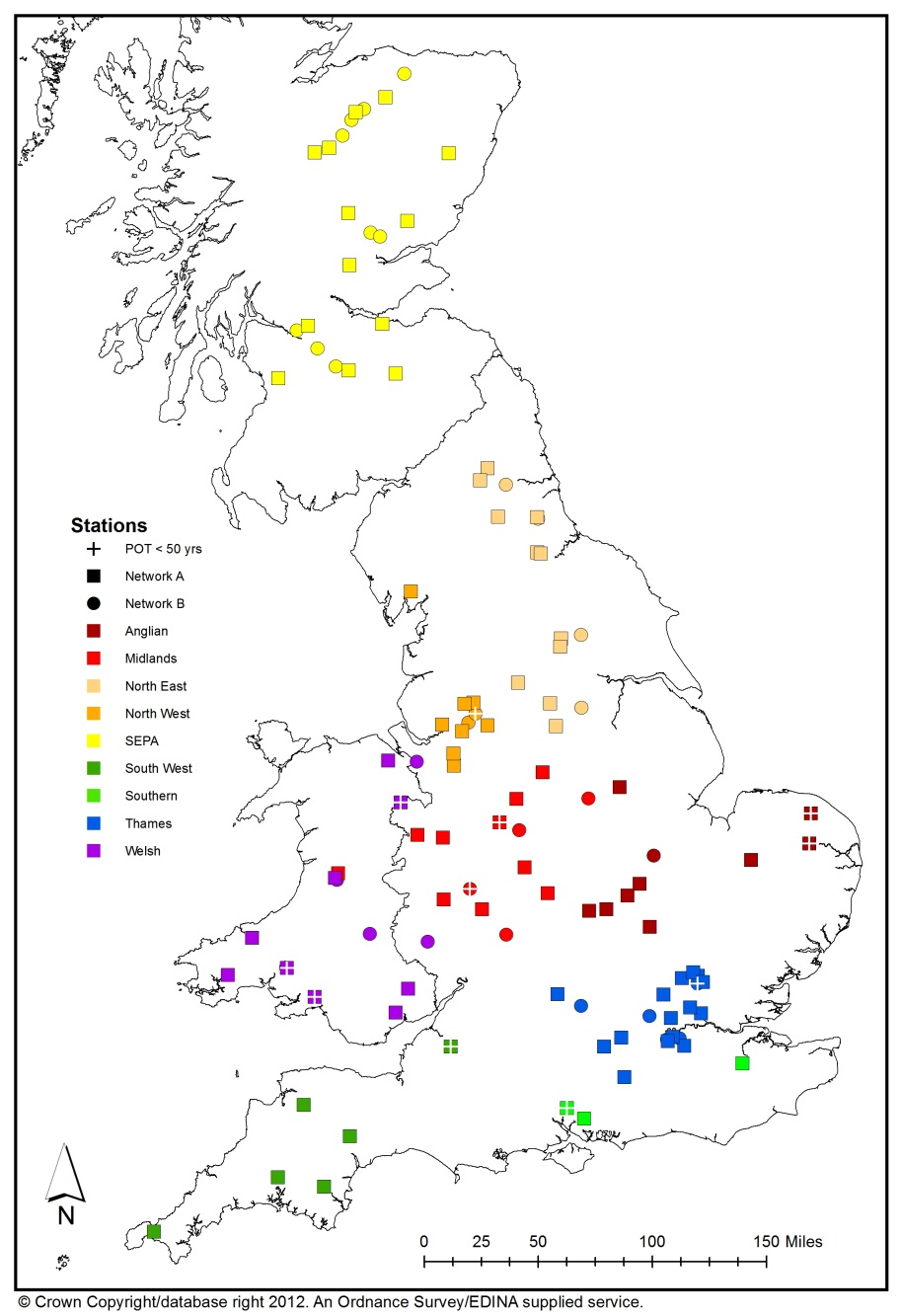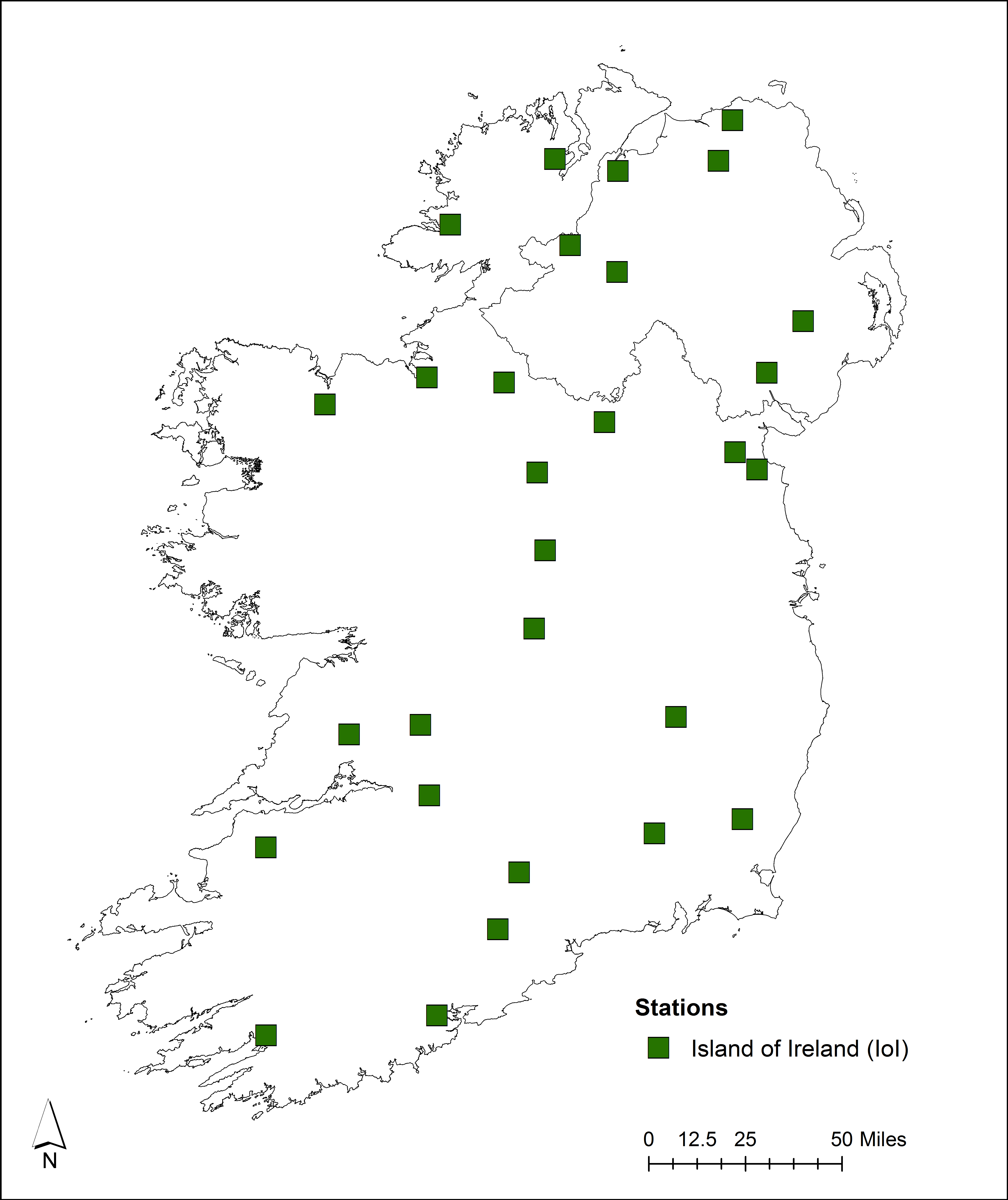
Location of the grid points over the British Isles.
| File format |
|---|
format(a) descriptive header line
for year = firstyear to lastyear (rows)
for month = 1 to 12 (columns)
format(31i3) each day of month
|
| Lamb Types - Number coding |
|---|
-1 U -9 non-existent day 0 A 20 C 1 ANE 11 NE 21 CNE 2 AE 12 E 22 CE 3 ASE 13 SE 23 CSE 4 AS 14 S 24 CS 5 ASW 15 SW 25 CSW 6 AW 16 W 26 CW 7 ANW 17 NW 27 CNW 8 AN 18 N 28 CN |
| Filename | Description |
|---|---|
| lwtlamb.dat | Lamb Weather Types - Lamb 1861-1997 |
Hulme, M. and Barrow, E. (Editors), 1997: Climate of the British Isles: present, past and future, Routledge, London, 454pp.
Lamb, H.H., 1972: British Isles Weather types and a register of daily sequence of circulation patterns, 1861-1971. Geophysical Memoir 116, HMSO, London, 85pp.
Lamb, H.H., 1991: British Isles daily wind and weather patterns 1588, 1781-86, 1972-91 and shorter early sequences (in 1532, 1570 and other years, notably 1688, 1689, 1694, 1697, 1703, 1717, 1783-4, 1791, 1792, 1795, 1822, 1825, 1829, 1845, 1846, 1849, 1850, 1854-5. Climate Monitor 20, 47-70.
| File format |
|---|
Description of columns: day month year PM-1000 W S F Z G Dir LWT Definitions: PM_1000 average pressure over the grid points W westerly flow S southerly flow F resultant flow Z total shear vorticity >G gale day Dir direction of flow LWT see above table |
 Location of the grid points over the British Isles. |
| Filename | Description |
|---|---|
| 20CR_1871-1947_ncep_1948-2025_12hrs_UK.dat | 1871-1947 20CR; 1948-present NCEP |
| 20CR_1871-1947_ncep_1948-2025_12hrs_UK.csv | as above in csv format (contains headers) |
| 20CR_1948-2010_12hrs_UK.dat | 1948-2010 (20CR to facilitate comparison) |
| ERA5_1979-2018_12hrs_UK.dat | 1979-2018 ERA5 |
The following files provide the output described at the other synoptic hours, but they do not contain the LWT:
| Filename | Description |
|---|---|
| ncep_1948_2025_00hrs_UK.dat | 1948-present NCEP 00hrs |
| ncep_1948_2025_06hrs_UK.dat | 1948-present NCEP 06hrs |
| ncep_1948_2025_18hrs_UK.dat | 1948-present NCEP 18hrs |
| Filename | Description |
|---|---|
| 20CR_1871-2010_00hrs_UK.dat | 1871-2010 20CR 00hrs |
| 20CR_1871-2010_06hrs_UK.dat | 1871-2010 20CR 06hrs |
| 20CR_1871-2010_18hrs_UK.dat | 1871-2010 20CR 18hrs |
The gale index G found in the above files is calculated from the following formula:
G = [F2 + (0.5Z)2]1/2where F is the resultant flow and Z is the total shear vorticity, see Jones et al (1993) for further details. In a similar vein to Hulme and Jones (1991) exceedances of a threshold have been counted and allocated a gale intensity:
G > 30 gale
G > 40 severe gale
G > 50 very severe gale
This was done annually and for an extended winter (NDJFMA)
| Filename | Description |
|---|---|
| gale_index_1200hrs_UK.csv | dated log of all G>30 events |
| ANN_G_thresh_counts_UK.pdf | Annual plots of the three thresholds |
| NDJFMA_G_thresh_counts_UK.pdf | Extended winter plots of the three thresholds |
 Location of the grid points over the North Sea. |
| Filename | Description |
|---|---|
| 20CR_1871-1947_ncep_1948-2025_12hrs_N_Sea.dat | 1871-1947 20CR; 1948-present NCEP |
| 20CR_1871-1947_ncep_1948-2025_12hrs_N_Sea.csv | as above in csv format (contains headers) |
| 20CR_1948-2010_12hrs_N_Sea.dat | 1948-2010 (20CR to facilitate comparison) |
| ERA5_1979-2018_12hrs_N_Sea.dat | 1979-2018 ERA5 |
The following files provide the output described at the other synoptic hours, but they do not contain the LWT:
| Filename | Description |
|---|---|
| ncep_1948_2025_00hrs_N_Sea.dat | 1948-present NCEP 00hrs |
| ncep_1948_2025_06hrs_N_Sea.dat | 1948-present NCEP 06hrs |
| ncep_1948_2025_18hrs_N_Sea.dat | 1948-present NCEP 18hrs |
| Filename | Description |
|---|---|
| 20CR_1871-2010_00hrs_N_Sea.dat | 1871-2010 20CR 00hrs |
| 20CR_1871-2010_06hrs_N_Sea.dat | 1871-2010 20CR 06hrs |
| 20CR_1871-2010_18hrs_N_Sea.dat | 1871-2010 20CR 18hrs |
See UK section for explanation.
| Filename | Description |
|---|---|
| gale_index_1200hrs_N_Sea.csv | dated log of all G>30 events |
| ANN_G_thresh_counts_N_Sea.pdf | Annual plots of the three thresholds |
| NDJFMA_G_thresh_counts_N_Sea.pdf | Extended winter plots of the three thresholds |
Compo, G.P., Whitaker, J.S., Sardeshmukh, P.D., Matsui, N., Allan, R.J., Yin, X., Gleason, Jr B.E., Vose, R.S., Rutledge, G., Bessemoulin, P., Brönnimann, S., Brunet, M., Crouthamel, R.I., Grant, A.N., Groisman, P.Y., Jones, P.D., Kruk, M.C., Kruger, A.C., Marshall, G.J., Maugeri, M., Mok, H.Y., Nordli, Ø., Ross, T.F., Trigo, R.M., Wang, X.L., Woodruff, S.D., Worley, S.J., 2011: The Twentieth Century Reanalysis Project. Q. J. R. Meteorol. Soc. 137 1-28. DOI:10.1002/qj.776.
Hulme, M. and Jones P.D., 1991: Temperatures and windiness over the United Kingdom during the winters of 1988/89 and 1989/90 compared with previous years. Weather, 46, 126-136, DOI: 10.1002/j.1477-8696.1991.tb05724.x
Jenkinson, A.F. and Collison, F.P., 1977: An initial climatology of gales over the North Sea. Synoptic Climatology Branch Memorandum No. 62, Meteorological Office, Bracknell.
Jones, P.D., Hulme, M. and Briffa, K.R., 1993: A comparison of Lamb circulation types with an objective classification scheme. Int. J. Climatol. 13, 655-663.
Jones, P.D., Harpham, C. and Briffa, K.R., 2013: Lamb Weather Types derived from Reanalysis Products. Int. J. Climatol. 33, 1129-1139, DOI: 10.1002/joc.3498
Kalnay, E., Kanamitsu, M., Kistler, R., Collins, W., Deaven, D., Gandin, L., Iredell, M., Saha, S., White, G., Wollen, J., Zhu, Y., Chelliah, M., Ebisuzaki, W., Higgins.,W., Janowiak, J., Mo, K.C., Ropelewski, C., Wang, J., Leetmaa, A., Reynolds, R., Jenne, R. and Joseph, D., 1996: The NCEP/NCAR 40-year reanalysis project. Bulletin of the American Meteorological Society, 77, 437-471.
The file mov_averages.pdf
contains flood indices based on the method of Wilby and Quinn
(2013) for Environment Agency regions in England and Wales, plus
the area overseen by the Scottish Environmental Protection Agency
(SEPA). The table below contains the data used to produce the
plots including the complete time series from which the moving
averages were calculated.
| Filename | Description |
|---|---|
| day_weights.csv | Complete time series |
| move_av_30dy.csv | 30 day moving average |
| move_av_90dy.csv | 90 day moving average |
| move_av_365dy.csv | 365 day moving average |
The map below shows the regions (by colour) and river gauging stations used to calibrate the flood indices. Stations were selected because they had at least 50 years of flood peak data.

Flood indices are reconstructed from the number of Peaks over Threshold (POT) river flows in relation to the prevailing daily Lamb Weather Types (LWTs). POT time series are derived for each station by determining how many times the river flow exceeds a threshold set for each gauge, recorded as the number of exceedances per water year (October to September).
The LWTs used by Wilby and Quinn (2013) are based on an objective classification of pressure patterns obtained from the 20CR and NCEP/NCAR re-analysis described above. Like the regional flood indices, these LWTs are provided from 1871 to present, updated daily.
Weather patterns such as the C-type tend to generate more frequent POTs whereas A-types are relatively flood poor. Hence, decadal variations in the frequency of these contrasting weather types can explain flood rich and flood poor periods. Since gauged flood data are rare (very few stations were operating prior to 1950), the association between recorded POTs and corresponding LWT enables consideration of flood clustering in time periods where only LWT data are available (1871 to 1950s).
The regional flood indices also help place contemporary events in a much longer context. For example, the 30 day moving average flood index in February 2014 reached a maximum weight value of 2.33 in the Southern region. This value has only been exceeded during five previous episodes in the last 144 years (1872, 1951, 1981, 1983 and 2000).
Overall, the most extreme flood index for the Southern region was 2.58 in November 2000. As with 2014 this high value was due to very persistent cyclonic weather lasting several weeks.
A flood index for the Island of Ireland (IoI) was subsequently produced by Harrigan (2016) following the approach of Wilby and Quinn (2013). The IoI flood index was calibrated over water years 1978-2009 using POTs based on Daily Mean Flows (DMFs) from the 29 stations shown in the map below.

Similar to Britain, the C-type weather pattern generates more frequent POTs across IoI. In general, IoI flood loadings are most similar to those for Wales where the CS-type is also found to be associated with a greater likelihood of high flows.
Harrigan, S. 2016. Exploring the Hydroclimatology of Floods: From Detection to Attribution. Unpublished PhD thesis. National University of Ireland Maynooth.
Lamb, H.H., 1972. British Isles weather types and a register of the daily sequence of circulation patterns. Geophysical Memoirs 116. London: HMSO.
Wilby, R.L. and Quinn, N.W. 2013. Reconstructing multi-decadal variations in fluvial flood risk using atmospheric circulation patterns. Journal of Hydrology, 487, 109-121.
|